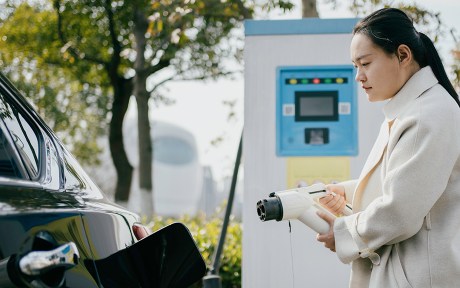
China’s aggressive policies to develop its battery-powered electric vehicle (BEV) industry have been successful in making the country the dominant producer of these vehicles worldwide. Going forward, BEVs will likely claim a growing share of global motor vehicle sales, helped along by subsides and mandates implemented in the United States, Europe, and elsewhere. Nevertheless, China’s success in selling BEVs may not contribute much to its GDP growth, owing both to the maturity of its motor vehicle sector and the strong tendency for countries to protect this high-profile industry.
China’s BEV Industry
The International Energy Agency’s (IEA) EV Outlook documents the policies that fostered China’s BEV industry. It notes that the government introduced incentives to purchase BEVs (subsidies to consumers, tax exemptions), implemented industrial policies (mandates to produce new energy vehicles, subsidies to producers), and undertook infrastructure investments in public charging stations. Justifications for this expensive push include advancing the country’s design and manufacturing skills, cutting oil imports, reducing urban air pollution, and addressing climate change.
Domestic production responded. Output of BEVs increased from around 1 million vehicles in 2020 to just over 6 million in 2023, with domestic BEV sales accounting for 23 percent of the passenger car market last year.
China’s BEV Production Has Increased Dramatically
Millions of units (12-month sums)
The IEA’s 2023 report recounted how hundreds of Chinese firms entered the field when the subsidies and incentives were implemented, but that most went bankrupt, leaving some dozen firms to produce BEVs in a broad price range. They describe a market with some vehicles sold at very low prices, with the average price of the smallest BEVs in China at around $10,000 in 2022, compared to $35,000 in Europe and the United States, albeit with a substantially shorter battery range. The price differential is also evident in the SUV segment, with the average price in China at $35,000, much lower than the $65,000 average in the other two markets even though the average ranges are similar across the three regions.
Recipe for Growth?
While technologically advanced, the extent that BEVs can contribute to GDP growth is limited by the maturity of the motor vehicle industry, with passenger car sales having peaked in 2017. This is a restraining factor as BEVs do not represent an innovation that creates new demand, like the introduction of personal computers or cell phones. Instead, they’re a new version of a familiar product whose sales may not grow much beyond current levels.
BEVs might still increase the industry’s contribution to GDP growth if customers switched away from imports to domestically produced vehicles. The potential gains, though, are likely to be small, as China used very high tariffs to force foreign firms to open local plants, with the requirement that they have a domestic partner. The arrangement means that foreign firms keep a share of the profits from their Chinese operations while the value-add embedded in domestic motor vehicle sales is almost entirely created in China.
Not having a meaningful number of imports implies that any switch away from passenger cars running on internal combustion engines (ICE) to BEVs will have winners and losers inside China, reminiscent of a zero-sum game, but will not do much to lift GDP. If anything, technological improvements in batteries that lower the average price of motor vehicles, while a benefit to consumers, will shrink the output of the motor vehicle sector unless matched by a corresponding increase in unit sales.
One bright development for China’s economy has been an increase in BEV exports. Foreign sales of these vehicles have risen from around 250,000 units in 2020 to 500,000 units in 2021, 1.0 million units in 2022, and 1.5 million units in 2023, according to data from China’s General Administration of Customs. Unfortunately, the UN Comtrade database, with its breakdown of exports by country (the HS code for BEVs is 870380) available through 2022, seen in the chart below, shows the need to adjust these numbers. It is apparent that the category includes both BEVs and cheap electric carts, with the value of vehicles shipped to Bangladesh, India, the Philippines, and Thailand averaging just $2,500 in 2022—compared to $30,000 for vehicles going to Europe. It makes sense, then, to subtract out sales to these four countries to get a better measure of BEV exports and, indeed, the average value without these four is close to Europe’s average value. Such an adjustment raises the 2022 growth rate for BEV exports (122 percent versus 90 percent) but lowers the volume of exports to around 700,000 units. The 2023 breakdown is not available, but the adjusted total will likely be over 1 million units.
China’s BEV Exports to Europe Have Surged
Thousands of units
Notes: Emerging economies include Bangladesh, India, the Philippines, and Thailand. Middle East includes Israel, Jordan, and the UAE.
Protectionism
The extent of export gains for China depends on both the share of BEVs purchased abroad and China’s share of these BEV sales. Consider Europe, which received over half of China’s BEV exports in 2022, 436,000 units. (Note that exports to the United States were trivial due to very high U.S. tariffs.) The European Automobile Manufacturers Association estimates that BEV sales in Europe equaled 1.2 million in 2021 and 1.6 million in 2022, with total sales of motor vehicles dipping from 11.8 million to 11.3 million. Given the rising popularity of BEVs (increasing from 10 percent to 14 percent of the market) and China’s higher share of that region’s BEV sales (17 percent to 28 percent), a quick calculation shows that China’s BEV share of total vehicle sales doubled from 2 percent to 4 percent in one year. Assuming that China’s exports to Europe grew at the same rate as its total BEV exports, then Chinese vehicles made up 35 percent of Europe’s higher BEV sales in 2023, accounting for 5.5 percent of total motor vehicle sales in the region.
Such gains may soon flatten out, both from greater competition as European plants work to catch up and from political pressure to put a cap on China’s exports. China itself is a case study of a government protecting a favored domestic industry, with the U.S.-Japan Voluntary Export Restraint (VER) program in the early 1980s being another. The oil shocks of 1973 and 1979 created a competitive advantage for Japanese firms that had specialized in fuel-efficient vehicles. The VER program was designed to protect a highly visible U.S. manufacturing industry under an agreement that Japanese firms would have to open plants in the United States in order to sell more to the U.S. market. These experiences suggest that Chinese firms, whether producers of BEVs or the batteries they run on, will face implicit and explicit pressure to build facilities in foreign markets if they want to grow their sales.
Significant Gains Elsewhere
While BEVs may have limited potential to increase the motor vehicle sector’s contribution to Chinese GDP, that does not diminish the other significant gains from the policies that fostered the industry, such as the profits to be made from any new foreign operations, the technological and manufacturing spillovers to the rest of the economy, and the replacement of imported petroleum products with domestic renewable energy. Indeed, the EIA’s 2023 EV report forecasts that China’s adoption of electric vehicles will lower its crude oil consumption in 2030 by 2 million barrels per day, which is equal to 12 percent of the country’s current liquid fuel consumption.

Thomas Klitgaard is an economic research advisor in International Studies in the Federal Reserve Bank of New York’s Research and Statistics Group.
How to cite this post:
Thomas Klitgaard, “Can Electric Cars Power China’s Growth?,” Federal Reserve Bank of New York Liberty Street Economics, February 28, 2024, https://libertystreeteconomics.newyorkfed.org/2024/02/can-electric-cars-power-chinas-growth/.
Disclaimer
The views expressed in this post are those of the author(s) and do not necessarily reflect the position of the Federal Reserve Bank of New York or the Federal Reserve System. Any errors or omissions are the responsibility of the author(s).













 RSS Feed
RSS Feed Follow Liberty Street Economics
Follow Liberty Street Economics
JHill:
Thanks for your question. It highlights that to get the full benefits of electrifying transportation requires increasing the use of renewable energy. Still, it has been argued* that a BEV operating in the United States is much greener that a conventional vehicle under the assumption that it’s drawing power from the average mix of fossil fuel and renewable power plants. The EPA** also concludes that BEVs typically have a smaller carbon footprint than gasoline cars, even when accounting for the electricity used for charging.
* See, for example: https://www.nytimes.com/2021/03/02/climate/electric-vehicles-environment.htmls
** https://www.epa.gov/greenvehicles/electric-vehicle-myths
Thomas,
Interesting, thorough article. One question: while BEVs can improve urban air pollution, to the extent that China’s electricity generation is heavily reliant on coal, has BEV expansion paradoxically increased green house gas emissions from China?